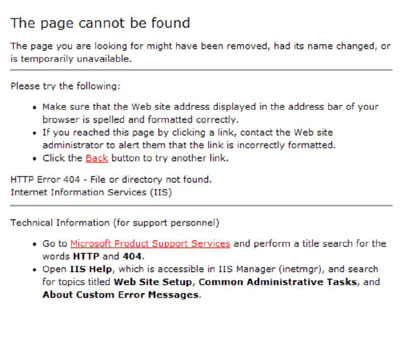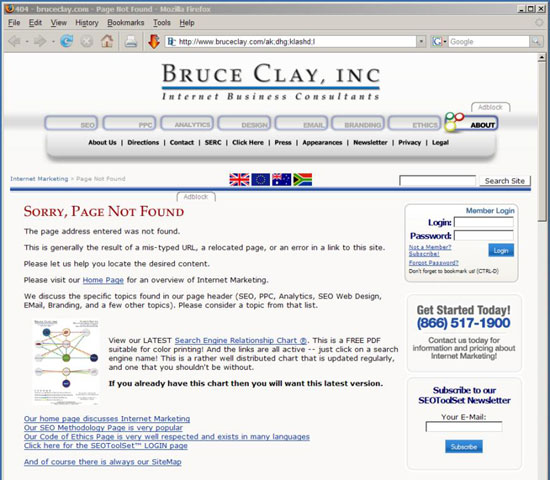Your job as a search marketer is to make your site easily navigable for both users and the search engines. Your navigation should be clearly and uniformly laid out, your internal linking structure should make sense to a user, and a site map should offer links to the most important pages on your Web site. Part of this responsibility includes acknowledging that mistakes happen and offering users a roadmap for when errors arise.
Despite your best efforts, users will click on broken links, they’ll mistype a URL, guess wrong at what they think a URL should be or try to access a bookmarked page that has since moved. Users do all sorts of things to get themselves confused; sometimes it’s not even their fault. And when they do, they’ll meet your 404 page.
A 404 or Page Not Found error is an HTTP standard response code that alerts your visitors and the search engines that the page they were trying to access no longer exists. By creating a custom page that addresses the needs of your users, you help them get back on track and find the information they were looking for. You give them a reason to stay on your site and not seek out the information elsewhere. Over time this can add up to a significant number of saved conversions.
The question is: What kind of 404 page do your visitors see when they meet a roadblock? Is it friendly and appropriate to their needs or does it look like the default 404 page - cold and ugly, offering them nowhere to go but back to the page that lead them astray? Even worse, does it redirect users back to the home page without explaining or even acknowledging the error?
Our experience tells us that creating unique 404 pages is often one of the most overlooked elements in a search engine optimization campaign. Clients become so consumed with creating great content, adding links, and mastering all the other on-page and off-page factors that go into optimization that they ignore the importance of keeping users on their site when a problem arises. Unfortunately, they do this to their own detriment.
Imagine you’re a searcher on the hunt for a new pair of cowboy boots. You’ve spent time researching the various styles and fit options and now you’re ready to make a purchase. You head to SEOCowboyBoots.com, your favorite stop for cowboy-related merchandise, and come across a pair of boots that you think meets your exact needs.
One problem: You go to view the product information of the pair you’re interested in and you’re hit with a default 404 page that looks something like this:

There’s no navigation, no links to relevant pages, nowhere to go but back, and no way to get back to your boots.
Are you going to stick around and try to figure out what happened or are you going to go the next site on your list, a site you’re confident will have your boots?
You’re going to bail out on the conversion path and go somewhere else.
Most users are intimidated by a default 404 error page. Essentially, you’ve just scolded them for doing something wrong and given them no way to make it right. Obviously, you do not care about their needs, so why should they stay on your site?
The most effective 404 pages are invisible to users because they actually become part of the site. They use the same site template, they’re clearly written, and instead of scaring users away, they invite them to continue interacting with your site.
The five Must Have’s for every custom 404 page are:
- An apology for the error (even if it user error)
- A prominent search box
- A link to your site map
- A link to your home page
- Links to the other main areas of your site
On BruceClay.com, we go above and beyond the five Must Haves. Our 404 page includes our full navigation, a link to our home page, an area for SEOToolSet members to log in, a link to our site map, as well as links to other popular areas like our Search Engine Relationship Chart, SEO Methodology page, and our Code of Ethics. We’ve intentionally made it really easy for visitors to find the pages most relevant to their needs. We do this because we believe it aides in our search engine optimization goals and because we want to make it easy for users to navigate our site.

When appropriate, we sometimes encourage clients to create 404 pages that include a touch of humor. Make light of the situation; acknowledge the goof and encourage users to get back on track and dig deeper into your site. If you’re that site selling cowboy boots, display an image of a cowboy stuck in his own lasso, a boot with its heel broken off, or a rodeo clown two seconds away from getting pummeled. There’s no rule that says your error page has to be boring. Keep users entertained and they’ll be more forgiving of the casual misstep.
There’s also no rule that says your error page has to include the frightening term “404 Error Page” anywhere on it. This phrase provides no value to your users. Most of them don’t know what it means, nor do they care to. All they want to know is how to get to the page they were originally looking for.
Custom 404 pages aid search engine optimization by ensuring that more of your pages are indexed. If you leave the spiders to find a default 404 page you’re throwing a roadblock in front of them that they have no way to get over. Search engines can’t hit the back button or use the other advanced features of your Web site. All they can do is follow links. If they come across a bad link and you don’t give them anywhere else to go, they’ll leave your site. This may result in entire sections of your site not being indexed. Creating a custom 404 page that includes links to your site map and your site’s most popular pages will help prevent this from happening. You have to give the engines something to follow.
Providing access to your site map becomes even more beneficial since the engines will continually return to your site to see if those nonexistent pages have returned. If they have, they’ll reindex them. If they haven’t, they’re once again left with your 404 page and all of your relevant links.
Something else to consider is that if you’re using a 404 that quickly redirects back to home page, you may be penalized. The search engines could potentially see the redirect and take it as a sign that cloaking. In most cases, it’s in your best interest to include a custom 404 error page.
You may even want to create one for every occasion and possible misstep. With just a basic understanding of JavaScript, site owners can create dynamic 404 pages that are specific to what went wrong. If a user click on a broken link, you can create a page that apologizes and gives visitors a place to report the broken link. If they’ve clicked on a product page that no longer exists, you can design a page that includes links to related products. Or you can take a one-size-fits-all approach and deliver one 404 page regardless of what caused the error. Find what works for your site.
When you design your custom 404, make sure you create it to be larger than 512 bytes. This is to ensure that your server will actually display the page you’ve created. If it’s under 512 bytes, some browsers will assume that is the boring default error page and replace it on their own. After spending the time and energy to create a page that stands out and addresses your user’s concerns, you don’t want to leave the decision of which page is shown to your browser.
We recommend adding to the top of your 404 page so that the search engines will not index this page. The last thing you want is for your 404 page to start ranking in the engine’s index.
Once you’ve created the page, you need to upload the page to your server and tell it which page to use. Depending on which kind of server you are using, this is done differently.
To do this for a Microsoft IIS Server, open up your “Internet Service Manager” and click on the site you want to set the custom 404 error page for. From there, select “Properties”, and then “Custom Errors” from the list of Radio tabs. Once selected, scroll down until you come to the file associated with your 404 error page. You can then edit this file or upload a new one for your server to display.
For a Unix server, modify the .htaccess file (create one in new text document if you do not already have an .htaccess) to include the command(s):
ErrorDocument 404 /404.htm
ErrorDocument 403 /404.htm
Note that this will redirect all 404 errors (File not found) and 403 errors (Forbidden) to your custom page.
Save the modified .htaccess and you’re done.
Making your site easily navigable and addressing visitor concerns will keep users happy and planted on your site. An optimized 404 page is one that blends in with your site and seamlessly gets visitors on their way to a conversion again.
---------
by Lisa Barone is a Sr. Writer at Bruce Clay Inc.




5 comments:
nice post thanks for sharing this article
Good share!very useful.Thanks
amazing good article nice post .....
Your post is really great and I appreciate your straight approach.
Excellent blog.I found it very interesting and at the same time very informative.Thanks!!!
Solar pv panel
power inverters
ups prices
Solar Tubewell
Post a Comment